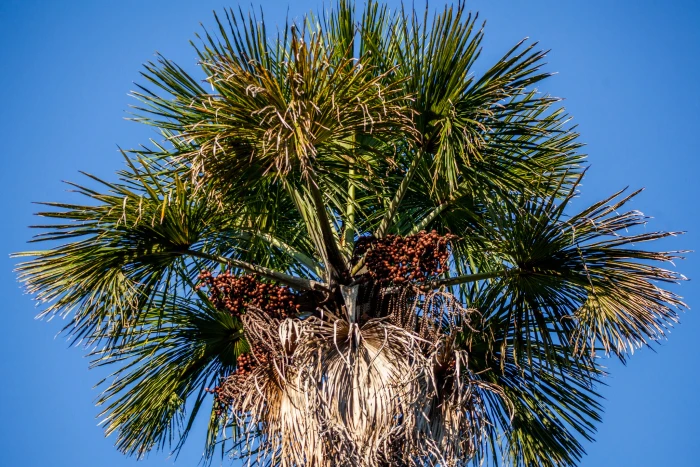Moriche Palm
(Mauritia flexuosa)
Moriche Palm (Mauritia flexuosa)
/
/

João D'Andretta
CC BY 4.0
Image By:
João D'Andretta
Recorded By:
Copyright:
CC BY 4.0
Copyright Notice:
Photo by: João D'Andretta | License Type: CC BY 4.0 | License URL: http://creativecommons.org/licenses/by/4.0/ | Rights Holder: João D'Andretta | Publisher: iNaturalist | Date Created: 2021-06-29T16:57:09-07:00 |

























Estimated Native Range
Climate Requirements for Groningen, Netherlands
| This Plant | Your Site | Plant Suitability for Your Location | ||
|---|---|---|---|---|
| • Precipitation | 29" - 175" | 32" | Your precipitation may be insufficient for this plant. Irrigate N" / year. | Irrigate N" / year |
| • High Temp. | 70°F - 98°F | 71°F | Your summer temperatures are normal for this plant. | Excellent |
| • Low Temp. | 37°F - 73°F | 31°F | Your winter temperatures may be too cold for this plant | Too cold |
This plant should grow well at your location with about N inches per year (Y minutes per month) of irrigation.
Summary
Mauritia flexuosa, commonly known as the moriche palm or aguaje, is a palm tree native to the Amazon rainforest and Orinoco basin, thriving in swamps, wetlands, and other water-rich environments. This species is particularly associated with the "morichales", a type of palm swamp found in the region. It is a slow-growing, evergreen palm that can reach up to 115 feet in height, with a straight, stout trunk and large, fan-shaped leaves forming a rounded crown. The moriche palm produces yellowish, inconspicuous flowers that are followed by chestnut-colored fruit, notable for their shiny, scaly covering. The fruit is edible and highly valued for its nutritional content, leading to the tree’s cultivation for various products, including juice, wine, and ice cream.
The moriche palm is a keystone species, supporting a wide array of wildlife such as birds, tapirs, peccaries, fish, and monkeys, which rely on its fruit as a food source. It is also culturally significant, providing materials for local uses such as fibers for crafts and construction, and edible larvae that are considered a delicacy. In cultivation, the moriche palm requires a consistently moist environment and does not tolerate drought. It prefers full sun to partial shade and can be used in large-scale landscape projects, botanical gardens, and as a focal point in tropical-themed gardens. While it is not commonly grown in average home gardens due to its size and specific water needs, it is an important plant for ecological restoration and conservation projects in its native range.CC BY-SA 4.0
The moriche palm is a keystone species, supporting a wide array of wildlife such as birds, tapirs, peccaries, fish, and monkeys, which rely on its fruit as a food source. It is also culturally significant, providing materials for local uses such as fibers for crafts and construction, and edible larvae that are considered a delicacy. In cultivation, the moriche palm requires a consistently moist environment and does not tolerate drought. It prefers full sun to partial shade and can be used in large-scale landscape projects, botanical gardens, and as a focal point in tropical-themed gardens. While it is not commonly grown in average home gardens due to its size and specific water needs, it is an important plant for ecological restoration and conservation projects in its native range.CC BY-SA 4.0
Plant Description
- Plant Type: Tree
- Height: 65-100 feet
- Width: 20-30 feet
- Growth Rate: Slow
- Flower Color: Green, Yellow
- Flowering Season: Spring, Winter
- Leaf Retention: Evergreen
Growth Requirements
- Sun: Full Sun
- Water: High
- Drainage: Slow, Standing
Common Uses
Edible*Disclaimer: Easyscape's listed plant edibility is for informational use. Always verify the safety and proper identification of any plant before consumption., Water Garden
Natural Habitat
Native to the Amazon rainforest and Orinoco basin, thriving in swamps, wetlands, and morichales
Other Names
Common Names: Moriche Palm, Ita, Neí, Aguaje, Burití, Ite Palm, Ité Palm, Buriti
Scientific Names: Mauritia flexuosa, Mauritia flexuosa var. venezuelana, Mauritia minor, Mauritia sagus, Mauritia setigera, Mauritia sphaerocarpa, Mauritia vinifera, Saguerus americanus
GBIF Accepted Name: Mauritia flexuosa